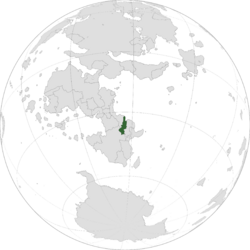Schennland
Republic of Schennland Freistaat Schennland | |
|---|---|
| Anthem: Schennische Fahnenhymne Schennish Flag Hymn | |
 Location of Schennland in Aurelia. | |
| Capital and largest city | Harburg |
| Official languages | Dolch |
| Demonym(s) | Schennish |
| Government | Unitary parliamentary republic with an executive presidency |
• President | Gustav Hannemann |
• Vice President | Markus Hahn |
• President of the Nationalrat | Paul Schmidt |
| Legislature | Nationalrat |
| Independence from Dolchland | |
| Area | |
• Total | 183,506 km2 (70,852 sq mi) |
| Population | |
• 2024 estimate | 15,776,998 |
• Density | 86.0/km2 (222.7/sq mi) |
| GDP (nominal) | 2024 estimate |
• Total | 307.534 billion |
• Per capita | 19,493 |
| Gini (2020) | medium |
| HDI (2020) | very high |
| Currency | Schilling (S) (SCS) |
| Time zone | UTC-4 |
| Date format | DD/MM/YYYY |
| Driving side | right |
| Calling code | +65 |
| Internet TLD | .sc |
Schennland (Dolch: [ˈʃɛnlant]), officially the Republic of Schennland (Dolch: Freistaat Schennland), is a country in southeastern Aurelia. It lies between the Typhon Sea to the north and the Sila Mountains to the south. The country has a population of 15.78 million, covering an area of 183,500 km² and sharing land borders with Ionio to the east, Kahokiaki to the south, and Anatean-occupied Azuria to the west. The capital and largest city of Schennland is Harburg; other major cities include Gladbach, Bartelshafen, and Pisekow.
The lands surrounding the Schennach river have been inhabited by native peoples for millennia, dating back to at least 5000 BCE. By the time of the first Argic explorers, the area was inhabited by the X people. The country was first settled in the 16th century by Dolch settlers and traders, establishing the port city of Harburg at the mouth of the Schennach river. The fertile valleys upstream were later settled for use in farming, vineyards, and livestock. A growing republican sentiment in the late 18th century capitalized on Dolch instability during the War of the Habstrian Succession to revolt and declare independence as an independent Schennish republic.
In the modern day, Schennland is a developing country with a diverse economy, containing growing agricultural, manufacturing, and tourism sectors.
Etymology
The country derives its name from the Schennach river, which starts in the Sila Mountains and flows north through much of the country until it meets the ocean at Harburg. When Dolchic colonists first reached the area, they recorded that the natives called the river Schendag, a corruption of the native Sachendaga. Schendag eventually changed to Schennach, as -ach is a common suffix in Dolch for rivers.
Geography
The country is made up of river valleys running the length of the country, from the Sila Mountains in the south to the river mouth at Harburg in the north. Here lie coastal plains along the Typhon Sea.
History
Politics
Schennland is a unitary constitutional republic and representative democracy. Multi-party elections are held every five years, unless a snap election calls for elections to come sooner. National elections to the Nationalrat legislature are run using a party-list proportional election.
The country is made up of seven provinces and one autonomous city, Harburg. Each of the eight administrative divisions have limited self-autonomy, with local elections' governance.

